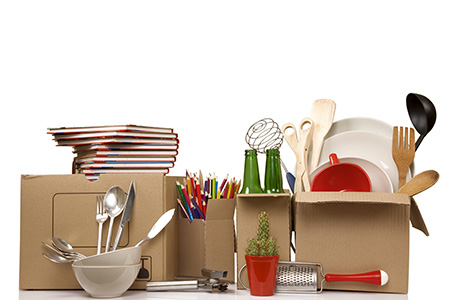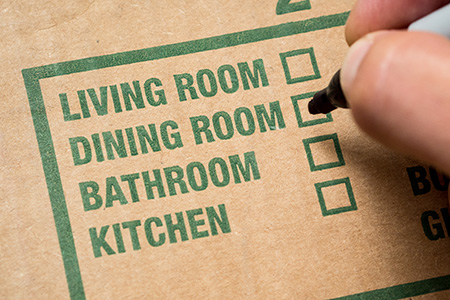Decluttering For a Home Move
The fewer items you have to pack, the cheaper and quicker your packing will be.
Less packing boxes means less space you will need on the removal van, and less time it will take to physically move to your new home.
The result: Your home move will cost you less money and take less time!
So how do you declutter your home ready for a home move?
Make a Floor Plan of your new home. We will cover this topic in more depth in the next section but having a floor plan will help you determine what furniture will fit in your new home and therefore if it is worth the effort or expense of moving that item.
MDF type furniture is usually not worth the expense or risk of dismantling and moving. The fixings often are ruined when you try to take them apart and the wood itself is easily chipped.
Look at everything you own and ask yourself some simple questions:
- Do I absolutely love this item?
- If I had the money would I buy this item again?
- Is this item irreplaceable, either financially or sentimentally?
- Is it cheaper to sell this item and replace it when I get to my new home?
- When was the last time I used or wore this item?
Be as ruthless with your decluttering as you can be. Remember this is all about saving money and making your home move easier.
Top Tips For Decluttering When Moving Home
- Declutter before you get an in-home removals estimate. The estimate will be far more accurate if the removal firm can see exactly what they are charging you to move.
- Leave time to get rid of things. Make sure you allow enough time to sell and donate the things you no longer need.
- Create a plan. Decide which rooms to start with and set yourself a realistic date of clearing those rooms.
- Get in the right frame of mind. Keep in mind that you really only need to keep the things that are irreplaceable to you.
- Is it cheaper to replace or pay to move it? Look at all your possessions. Then decide whether it is cheaper to replace the item when you get to your new home or pay to pack and ship it.
- Declutter non-sentimental items first. These will be the easiest things to let go of and it will motivate you when you see how much progress you have made.
How to Declutter for a Home Move
 The easiest way to organise your decluttering is the 3 pile method.
The easiest way to organise your decluttering is the 3 pile method.
- Pile 1 is for items you will not part with
- Pile 2 is items that you can sell or donate
- Pile 3 is for recycling/throwing away
Discover where to donate things to in this guide.
Decluttering Timeline
- Week 12. Plan to start your decluttering about 12 weeks before you intend to move home.
- Start with the least used items/rooms such as the shed, garage, or attic.
- Sort through all your documents, seasonal clothing, and decorative items.
- Week 8. 8 weeks before you move you should be ready to get your in-home moving survey done.
- Week 6. You can start now on decluttering everything else in your home.
- Week 4. Time for a car boot sale or to get everything that you want to donate collected.
- Week 2. By now you should just have your essentials left to pack and the decluttering should be finished.
How to Declutter a Garage or Shed or Loft
These are usually the hardest places to declutter as they tend to get everything and anything thrown in there.
The good news is that half the things here you will have forgotten you had, have never used, or are broken, so they will be easy to part with.
- Work on an area of the room at a time.
- Gather all like for like items into one place, such as tins of paint in one place, tools in another. This way you will quickly realise you have 4 hacksaws and 13 half-empty tins of gloss white paint.
- Anything that is broken or date expired can be thrown out.
- Duplicate items can be sold or donated.
- If you have been hoarding stuff for other members of the family, get them to come and collect it.
Learn more in How to Declutter Your Loft
How to Declutter Furniture
- Create a floor plan so that you know whether your existing furniture will fit in the available space in your new home.
- Will your furniture fit through the hallway, or are the doorways narrower than your current home?
- Does your furniture fit with the style or period of your new home?
- Is your furniture mainly MDF so is likely to be damaged during the home move?
- Is it time to pass down your antiques so that others get the pleasure of owning them?
- Do you really need a 12 seater dining table now the kids have left home?
How to Declutter Books and Magazines
Without a doubt, there is something special about holding and reading a real paper book.
But most books and magazines you own have probably not been opened in years, and the vast majority of books are available for download online anyway.
Books and magazines are readily accepted by charities and doctors surgeries for example, as well as being easy to sell. But they are heavy and expensive to move to your new home.
This is a good opportunity to get rid of your old collection, and if you really want you can go to your new charity store and buy a whole new collection.
- Consider why you want to keep the book or magazine.
- Reference books. This information is readily available online.
- Kids’ books. Do they still read it? Have they outgrown it?
- Recipe books. Nearly every recipe in the world is available online.
How to Declutter Shoes and Clothes
- Consider where you are moving to and the type of life you will be leading. Moving to the country? Do you need those suits or high heels?
- Have you been keeping those jeans for 2 years now hoping that you will fit back into them one day? Now is the time to get rid of them.
- Still got your wedding dress sat in the loft? How about making cushion covers or giving it to a family member to make a christening dress from for example?
- Use some of the clothing you no longer want as padding in your moving boxes and then cut them up for cleaning cloths when you get to your new home.
- Now you have streamlined your clothing collection, do your shoes now not match your remaining clothes? Time to get rid of them then.
- Not gotten around to re-heeling those shoes in the last 3 years. They can go.
- Anything that no longer suits your style or that does not fit can go.
You can learn how to declutter room by room in this epic guide on decluttering for a home move.

 One of the most common home moving mistakes is to pay to move furniture to a new home that will not fit.
One of the most common home moving mistakes is to pay to move furniture to a new home that will not fit. Get at least 3 quotes from removal companies so that you can compare the prices and services offered. Be wary of very low estimates as the price is likely to skyrocket on moving day.
Get at least 3 quotes from removal companies so that you can compare the prices and services offered. Be wary of very low estimates as the price is likely to skyrocket on moving day. Having to move home at the last minute can seem like a monumental task, but with the proper organisation it is possible to move home quickly.
Having to move home at the last minute can seem like a monumental task, but with the proper organisation it is possible to move home quickly. No matter how well organised your home move is, how competent your removal company are, there are still things that can happen on moving day that are beyond anyone’s control.
No matter how well organised your home move is, how competent your removal company are, there are still things that can happen on moving day that are beyond anyone’s control.


















